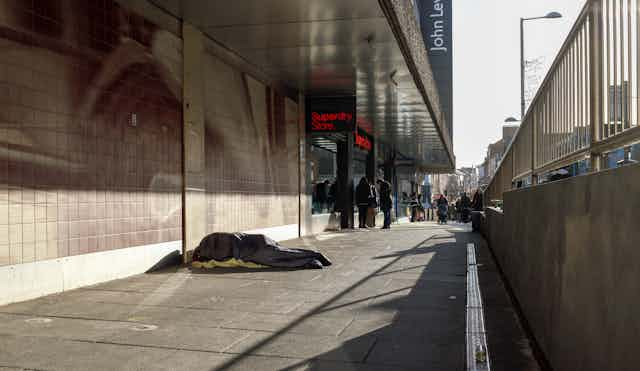The latest official count of rough sleepers across England found a 2% reduction from 2017 to 2018. But walking past snow-covered sleeping bags on the pavement of the UK’s major cities, it’s hard to believe that there’s been any improvement.
Context is important here: the total number of people estimated to be rough sleeping on a given night in 2018 is 4,677 – that’s 74 fewer people than the previous year. In cities where people move for work and opportunity, including London, Manchester and Birmingham, the figures are up - again. In any case, the count of rough sleepers should be approached with caution. These figures are only a snapshot, a head count taken in every local authority in England on a given night.
While it’s useful for councils to know, at a given point, how many people are homeless on the street, the data does not capture the movement of rough sleepers throughout the year, nor provide a clear picture of the number of people in need and what challenges they’re facing, such as poor physical and mental health, difficulties in accessing healthcare, education and employment and feelings of anxiety and hopelessness.
A complex issue
There are some areas where the number of rough sleepers in 2018 appeared to fall – drastically so in some cases. For example, in Brighton and Hove there were 114 fewer homeless people counted in 2018 than 2017, representing a 64% reduction. Yet in the London borough of Westminster, 306 people were counted sleeping rough – an increase of 41% from 2017. In my city, Leicester, the official count recorded is 31, the same figure as in 2017.
The overall picture is varied, so it’s tricky to pinpoint why the figures in some places improve while others worsen. It’s not just down to the cost of housing. In some areas, such as Westminster, where housing and living costs exceed wages and benefits income, the figures are high and rising. But in other cities with similar issues, homelessness is on the decline.
Funding certainly plays a role: as budgets for social housing and other public services have been drastically reduced throughout the last decade of austerity. There’s been an increase in rough sleeping and hidden forms of homelessness – such as young people sofa-surfing with friends - over the same period.
But there are pockets of funding targeted at reducing rough sleeping. In June 2018, the Ministry for Housing, Communities, and Local Government (MHCLG) announced £30m of funding for the Rough Sleeping Initiative (RSI), as a way of supporting 82 local authorities to reduce high numbers of people sleeping rough, before the count in November 2018.
While there’s been a small reduction of 2% in the official snapshot figures, it’s not really possible to say whether this is the start of positive trend in reducing street homelessness. For example, both Westminster and Brighton received targeted funding, but experienced very different outcomes.
In reality, the RSI funding will take time to affect the lives of people with such complex needs. It’s a welcome injection of funding for a sector that has faced relentless government cuts. But this short-term fix is unlikely to end rough sleeping any time soon.
The people behind the numbers
Funding is absolutely necessary to address homeless people’s range of needs – but it’s not the only factor. Getting to know the people behind the numbers in the count – understanding their stories and how they came to be sleeping on the street – can help agencies understand some of the complex and varied issues that lead to homelessness.
A team led by De Montfort University did this in Leicester as part of the European End Street Homelessness campaign, which has been learning lessons from across the continent and drawing on experiences from the US, where rough sleeping is a huge problem. We worked together with students at the university and a range of public sector and charity colleagues.
Read more: Homelessness: how other countries can avoid a US-style crisis
The report published in November 2017 recorded the number of people sleeping rough on the night of the government count (31). But it also included much more detailed survey questions, which explored the experiences of each homeless person. These allowed us to learn about the cumulative issues which had led people to sleep on the street. Many had experienced health problems and trauma.
Hearing these stories can help councils and charities to work out what sort of housing and assistance will work in the long term, to reduce the chance of people becoming homeless again. It can also give communities, media and local authorities the means to get rid of the stigma around homelessness, better understand the causes and target resources and support to help people off the streets.
Our project helped to secure RSI funding for the city, prompted the creation of the new Leicester Homelessness Charter and a longer term research partnership, to consider the benefits of a “housing first” approach, which provides a stable home and personalised support to help homeless people stay off the streets.
Getting to know the particular issues and stories that can lead to homelessness is vital to connecting homeless people to the right kind of help, and ultimately reducing or ending street homelessness. Projects such as the European End Street Homelessness Campaign provide a structured way to do that, for each local area. With the announcement of a 2% reduction in rough sleeping, it’s now more important than ever to keep learning the detail about homeless people’s experience, and acknowledge the complexity behind the headline figures.

